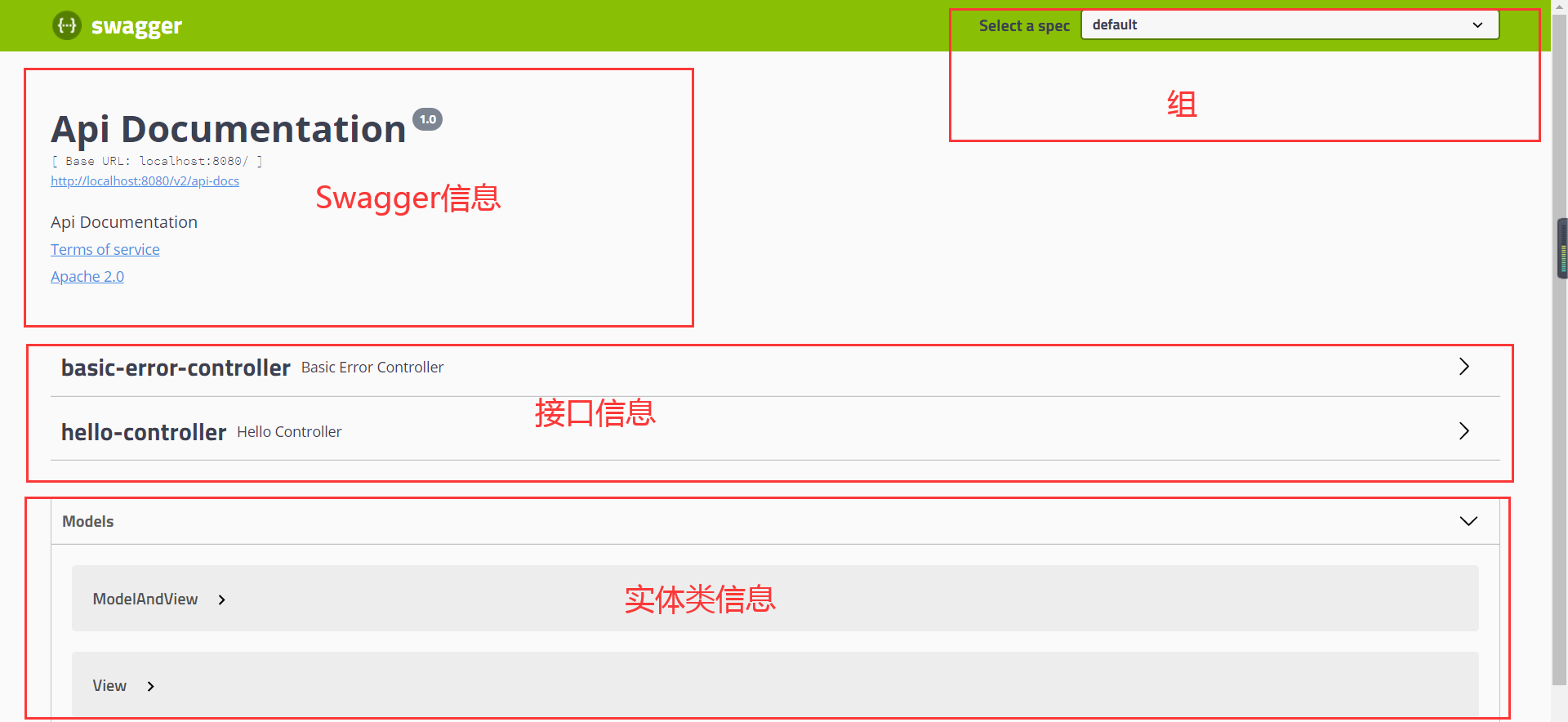Springboot中对Swagger2的基本管理
2021-06-09 18:06
标签:pac ref class contact res 判断 图片 list() 信息 只希望我的Swagger在生产测试环境中使用,在发布环境不使用,应该如何实现 思路: 1、判断是否是生产环境 flag=false 2、注入 enable(flag) 配置API文档的分组 如需配置多个组,创建多个Docket实例即可 1.我们可以通过Swagger给一些比较难理解的属性或者接口,增加注释信息 2.接口文档实时更新 3.可以在线测试 【注意】:正式发布项目的时候,一定要关闭Swagger!!!! Springboot中对Swagger2的基本管理 标签:pac ref class contact res 判断 图片 list() 信息 原文地址:https://www.cnblogs.com/HHY123/p/14486047.htmlSpringBoot集成Swagger2
1、新建springboot+web项目
2、导入相关的依赖
3、新建一个helloController进行测试
@RestController
public class HelloController {
@RequestMapping("hello")
public String hello(){
return "hello";
}
}
4、创建SweggerConfig
@Configuration
@EnableSwagger2 //开启Swagger
public class SwaggerConfig {
}
5、测试访问Swagger-ui——http://localhost:8080/swagger-ui.html

配置SwaggerConfig信息
@Configuration
//开启Swagger
@EnableSwagger2
public class SwaggerConfig {
//配置了 Swagger 的 Docket 的 Bean 实例
@Bean
public Docket docket(){
return new Docket(DocumentationType.SWAGGER_2).apiInfo(apiInfo());
}
//配置 Swagger 的信息 apiInfo
private ApiInfo apiInfo(){
//Contact("姓名","官网链接","邮箱")
Contact DEFAULT_CONTACT = new Contact("玄天", "。。。。。", "*****@qq.com");
return new ApiInfo(
"玄天的swagger学习测试", //title
"别怕梦长路远,总有星河照耀", //描述
"1.0", //版本
"urn:tos", //官网链接
DEFAULT_CONTACT, "Apache 2.0",
"http://www.apache.org/licenses/LICENSE-2.0",
new ArrayList());
}
}

Swager配置扫描接口
Docket.select()
//配置了 Swagger 的 Docket 的 Bean 实例
@Bean
public Docket docket(){
return new Docket(DocumentationType.SWAGGER_2)
.apiInfo(apiInfo())
.select()
//RequestHandlerSelectors:配置要扫描的接口方式
//basePackage:指定要扫描的包
//any():扫描全部
//none():不扫描
//withClassAnnotation():扫描类上的注解,参数是一个注解的反射对象
//withMethodAnnotation():扫描方法上的注解
.apis(RequestHandlerSelectors.basePackage("com.qf.springboot.controller"))
//过滤的路径
.paths(PathSelectors.ant("/qf/**"))
.build();
}
配置Swagge的自动启动
//配置了 Swagger 的 Docket 的 Bean 实例
@Bean
public Docket docket(){
return new Docket(DocumentationType.SWAGGER_2)
.apiInfo(apiInfo())
.enable(false) //enable是否启动Swagger,如果为false,则不启动
.select()
.apis(RequestHandlerSelectors.basePackage("com.qf.springboot.controller"))
.build();
}
思考题
//配置了 Swagger 的 Docket 的 Bean 实例
@Bean
public Docket docket(Environment environment){
//设置要显示的Swagger环境
Profiles profiles = Profiles.of("dev","test");
//通过 environment.acceptsProfiles 判断是否处于自己所指定的环境中
boolean flag = environment.acceptsProfiles(profiles);
return new Docket(DocumentationType.SWAGGER_2)
.apiInfo(apiInfo())
.enable(flag) //enable是否启动Swagger,如果为false,则不启动
.select()
.apis(RequestHandlerSelectors.basePackage("com.qf.springboot.controller"))
.build();
}
.groupName("玄天")
@Bean
public Docket docket1(){
return new Docket(DocumentationType.SWAGGER_2).groupName("A");
}
@Bean
public Docket docket2(){
return new Docket(DocumentationType.SWAGGER_2).groupName("B");
}
@Bean
public Docket docket3(){
return new Docket(DocumentationType.SWAGGER_2).groupName("C");
}
总结:
下一篇:检测是否引入jQuery